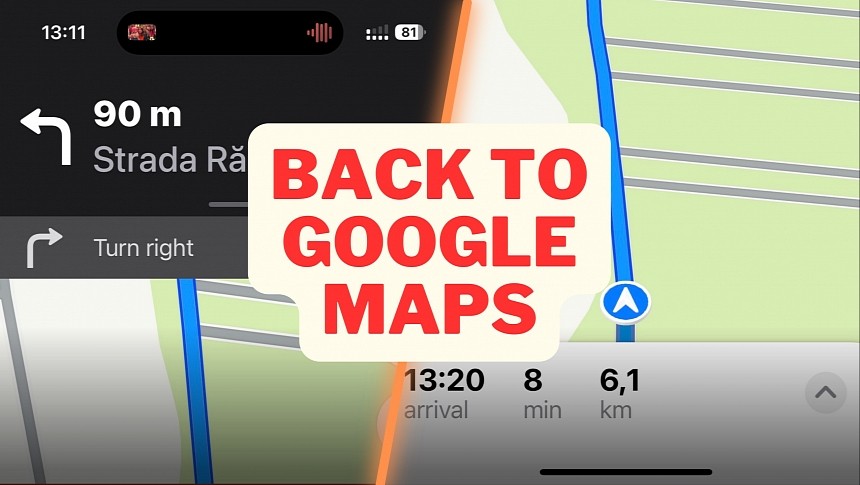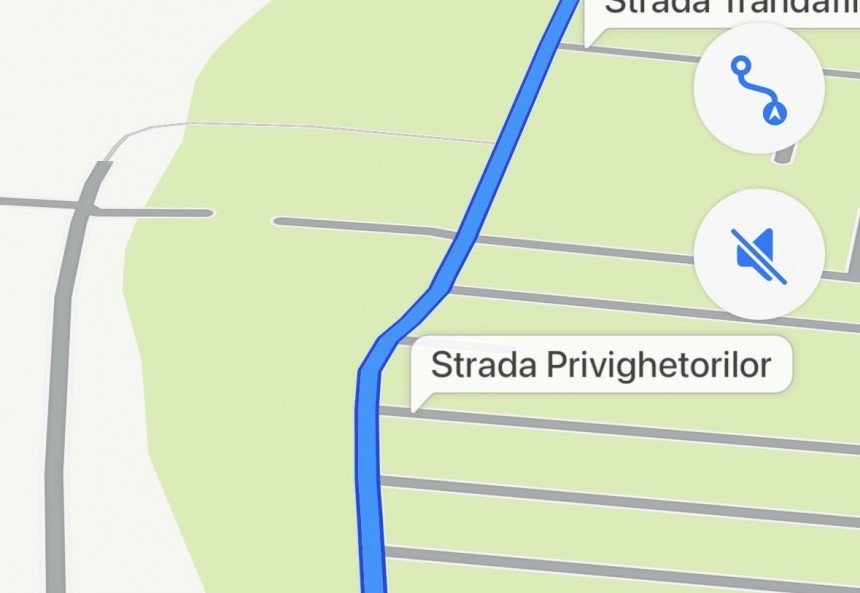Let's be honest about it: if you want to switch from Google Maps to something else, the new navigation app must be absolutely top-notch.
Google Maps is currently the number one mobile navigation app in the world for a very good reason: it has everything drivers need for both short and long journeys, including super-accurate maps, offline support, traffic data, and voice guidance.
Additionally, it sports a series of extras, such as a speedometer, the ability to send basic traffic reports, and parking locations.
As such, while the navigation world might seem very crowded, finding a worthy replacement for Google Maps isn't as easy as it sounds.
In the last few months, I've been increasingly tempted to switch to Apple Maps, not necessarily because it does something better than Google Maps (because it does, but more on that later) but due to the problems I encountered in Google's app. Google Maps just keeps misbehaving on every occasion, both on CarPlay and iPhone.
The app frequently loses the GPS tracking, so it no longer knows where I am. On CarPlay, it sometimes exhibits a very mysterious lag which means it's always one step behind in terms of turn-by-turn navigation.
The logical choice for anyone using an iPhone is Apple Maps. As the native mapping service on Apple devices, Apple Maps promises a very intriguing feature lineup, especially now that the availability of the detailed city experience has improved.
I decided to stick with baby steps, so my first objective was to test-drive the application for one week and then decide whether I should stick with it in the long term.
Unfortunately, my test ended abruptly after only 24 hours, as I quickly realized that Apple Maps still isn't in a place where it can serve as a full Google Maps alternative.
Let me start with my first shock. Apple Maps doesn't feature a speedometer, so if you check out the screen looking for how fast you're going, you won't find such information in the app. It can only show speed limit details, but on the other hand, you're not getting any data on the current speed. After years of using Waze, the lack of such a feature is a major inconvenience, even though, theoretically, you can always see the current speed on the instrument cluster.
Is worth knowing that your current speed differs from what you see on the dashboard, so navigation apps typically show more accurate data. I explained why in a previous article, so make sure you check it out.
The current maps in Apple Maps are poor, to say the least. I admit the detailed city experience is a massive makeover on this front, but the rollout of the updated maps takes place slowly across the world. Unless you live in the United States, Apple Maps offers only basic map data, and what's worse is that it doesn’t even include all roads.
I live in a residential area with a private street that's closed to traffic. For some reason, neither the street nor my building exists on Apple Maps.
Apple Maps also lacks business information. If you want to navigate to a specific place, you'd better use the full address, not the business' name. On my only day with Apple Maps, I launched the app to configure the route to my kid's kindergarten. Unexpectedly, the kindergarten could not be found, despite the same place already available on both Google Maps and Waze. Alternatively, I just entered the street name and number to have Apple Maps guide me to the address.
Apple Maps does not support satellite maps during navigation. Compared to Google Maps, which does offer such capabilities, Apple Maps only allows the standard map layer when route guidance is active. I don't always use satellite maps for navigation, but it occasionally comes in handy, especially when driving to a new location, and I need to figure out which way to go easier.
And last but not least, the overall performance of Apple Maps leaves a lot to be desired. I used the app on an up-to-date iPhone 14 Pro that runs just like on day one, and yet, Apple Maps still felt slow every now and then, particularly after making a turn. I don't know if it's just me or others experience the same problem, but Google Maps works perfectly on my iPhone.
At the end of the day, Apple Maps is a solid Google Maps alternative, especially in the United States, where the new maps already resolve many of the shortcomings I detailed above. The 3D navigation is also a major addition that makes Google Maps feel a little bit obsolete. However, satellite maps and offline support are missing from Apple Maps, and there's no indication the company would address them in the long term.
For now, if you're looking for a Google Maps alternative, Apple Maps is far from becoming the top choice. The navigation space includes many other solid choices, so at the end of the day, searching for a worthy solution is much harder than it seems.
Additionally, it sports a series of extras, such as a speedometer, the ability to send basic traffic reports, and parking locations.
As such, while the navigation world might seem very crowded, finding a worthy replacement for Google Maps isn't as easy as it sounds.
In the last few months, I've been increasingly tempted to switch to Apple Maps, not necessarily because it does something better than Google Maps (because it does, but more on that later) but due to the problems I encountered in Google's app. Google Maps just keeps misbehaving on every occasion, both on CarPlay and iPhone.
The app frequently loses the GPS tracking, so it no longer knows where I am. On CarPlay, it sometimes exhibits a very mysterious lag which means it's always one step behind in terms of turn-by-turn navigation.
The logical choice for anyone using an iPhone is Apple Maps. As the native mapping service on Apple devices, Apple Maps promises a very intriguing feature lineup, especially now that the availability of the detailed city experience has improved.
I decided to stick with baby steps, so my first objective was to test-drive the application for one week and then decide whether I should stick with it in the long term.
Unfortunately, my test ended abruptly after only 24 hours, as I quickly realized that Apple Maps still isn't in a place where it can serve as a full Google Maps alternative.
Is worth knowing that your current speed differs from what you see on the dashboard, so navigation apps typically show more accurate data. I explained why in a previous article, so make sure you check it out.
The current maps in Apple Maps are poor, to say the least. I admit the detailed city experience is a massive makeover on this front, but the rollout of the updated maps takes place slowly across the world. Unless you live in the United States, Apple Maps offers only basic map data, and what's worse is that it doesn’t even include all roads.
I live in a residential area with a private street that's closed to traffic. For some reason, neither the street nor my building exists on Apple Maps.
Apple Maps also lacks business information. If you want to navigate to a specific place, you'd better use the full address, not the business' name. On my only day with Apple Maps, I launched the app to configure the route to my kid's kindergarten. Unexpectedly, the kindergarten could not be found, despite the same place already available on both Google Maps and Waze. Alternatively, I just entered the street name and number to have Apple Maps guide me to the address.
And last but not least, the overall performance of Apple Maps leaves a lot to be desired. I used the app on an up-to-date iPhone 14 Pro that runs just like on day one, and yet, Apple Maps still felt slow every now and then, particularly after making a turn. I don't know if it's just me or others experience the same problem, but Google Maps works perfectly on my iPhone.
At the end of the day, Apple Maps is a solid Google Maps alternative, especially in the United States, where the new maps already resolve many of the shortcomings I detailed above. The 3D navigation is also a major addition that makes Google Maps feel a little bit obsolete. However, satellite maps and offline support are missing from Apple Maps, and there's no indication the company would address them in the long term.
For now, if you're looking for a Google Maps alternative, Apple Maps is far from becoming the top choice. The navigation space includes many other solid choices, so at the end of the day, searching for a worthy solution is much harder than it seems.








